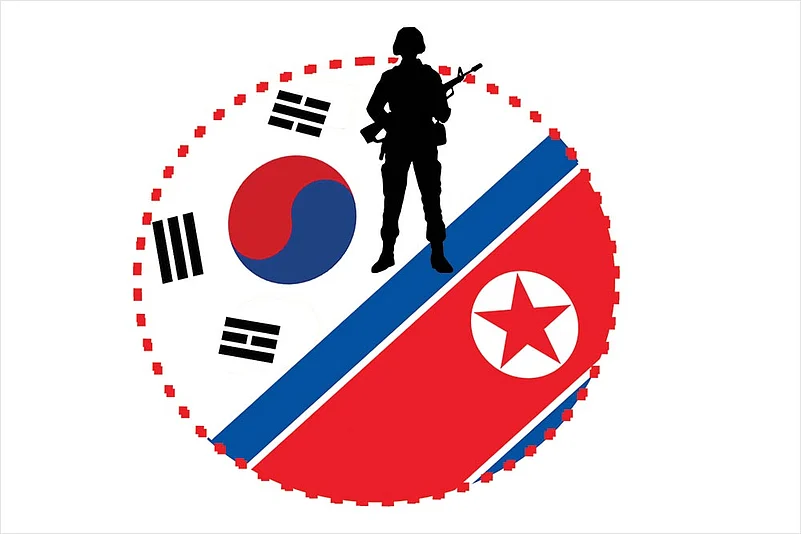The De-Militarised Zone is an oxymoron. About 50 km north of Seoul, the DMZ is a 4 km buffer between the two Koreas—the north of three generations of dictator Kims and a Yankee capitalist south. No doubt, this is the most militarised zone in the world. An outcome of the 1953 agreement that stopped the Korean War, the armistice stands its ground and that, technically, makes this the longest unfinished war, separating millions of families, creating opposite worlds on both sides of the 38th Parallel. The two worlds exist amidst tension, propaganda, rhetoric—fermenting within a common language, race and kimchi.
Not far from the DMZ is the “Third Tunnel of Aggression”, one of the four known tunnels between the Koreas. The South says North Koreans dug these with the intent to invade. The North says it was trying to mine coal. The South claims that the 1.6-km third tunnel could have transported 30,000 troops in an hour. The North laughed at the South’s “figment of imagination”. Nearly 37 years after its discovery, the ‘Third Tunnel’ is ferrying coal or soldiers but tourists like me. It’s well-lit, but the climb often gets steep. Helmets are a must, unless somebody wants to lose his head on the low, rocky roof. Our guide tells us: “The North Koreans spent a lot of money to build this tunnel. We now make good money from these through tourists like you.”
A little down is a lookout point on the South Korean side, with a row of fixed binoculars pointing towards the ‘enemy‘. I put a 500 Won coin into a slot and the optics spring to life. I get bright and impressive views of a North Korean village, Kijongdong—a propaganda model to show the Southerners the luxury and prosperity up North. A large North Korean flag flutters on a flagpole, once the tallest in the world. South Korea says Kijongdong’s buildings are concrete shells—like a massive film studio—and the lights are turned off and on to project an illusion of activity. North Korea calls it the Peace Village; it is known as Propaganda Village in the South.
About a mile south of Kijongdong is another village—Daeseong-dong on the South Korean side. This one has a massive flagpole too, with a huge South Korean flag. The villagers enjoy special privileges, pay reduced taxes and have no military conscription unlike their brethren elsewhere in the nation.
A board at Dorasan train station proclaims that Seoul is 56 km and Pyongyang is 205 km away. This station is in South Korea, though the tracks run north and there is no train service. The only people found there are soldiers and tourists. The squeaky clean station has more such impressive signboards. Like: “Not the last station from the south, but the first station towards the north”. A map of the proposed Eurasian railway shows how one can travel from Dorasan to Panmun in North Korea, then to Pyongyang, further on to China, Mongolia, Russia, Central Europe, France and the UK. The relaxed atmosphere at the station betrays no sign of the tension at the DMZ, a shout away. The military guards smile, some pose for photos. I bought a ticket from Dorasan to Pyongyang as a souvenir.
From Dorasan, I went to Imjingak Bridge where an old, rusty steam locomotive reminds of the Korean War—the thousand bullet holes puncturing the metal. A board, with chalk provided for visitors to write peace messages, was an easy temptation. I wrote in all caps: WITH LOVE FROM INDIA.
With guns and skirmishes, this is an almost impossible border for civilians to cross. Chung Ju-yung did it more than once in his lifetime. Born in a peasant family in the northern parts of undivided Korea in 1915, he sold his father’s cow (without his permission) for 70 Won and headed south. He cut wood, laboured in a sugar syrup factory, worked in a rice store, before landing in Seoul and setting up Hyundai—yes, that business conglomerate. Chung had always felt guilty about taking his father’s 70 Won and wanted to repay his debt. In 1998, at 83 and as chairman of Hyundai, he crossed the border to herd 500 cows into North Korea. As the convoy of Hyundai trucks loaded with cows rolled into the North, the Northerners gave a gift bag containing packets of cigarettes and liquor to each lorry driver. The big smile was a bonus. Chung died in 2001, but his crossing remains one of the most dramatic stories told on this tense border. It inspires hope. People could get back from the Bridge of No Return. End of the day, I returned, tired and not in style, to Seoul’s Gangnam district. Gangnam unstyle?



















